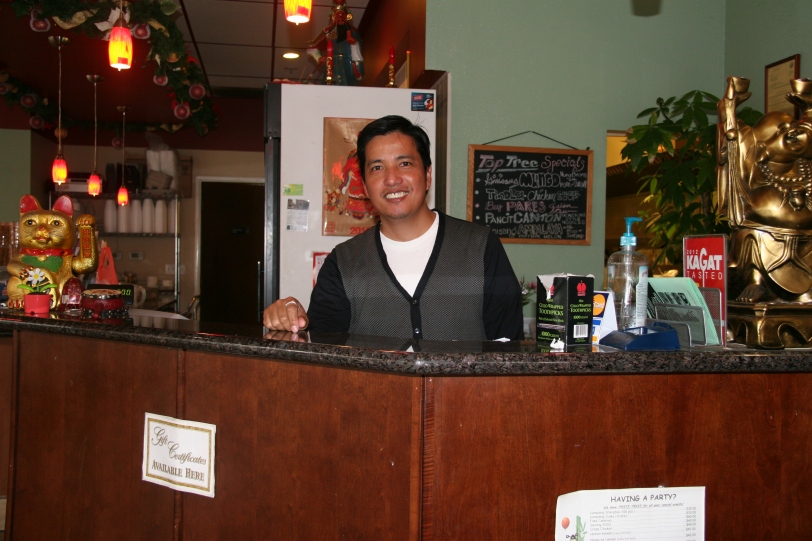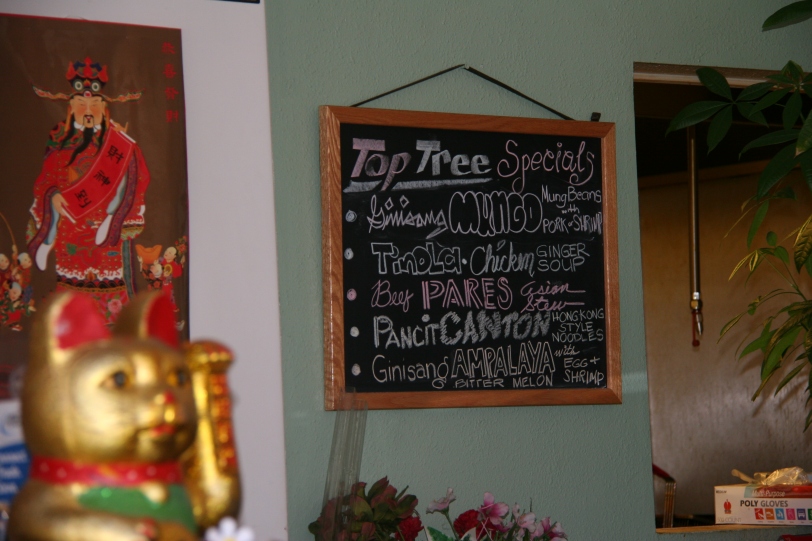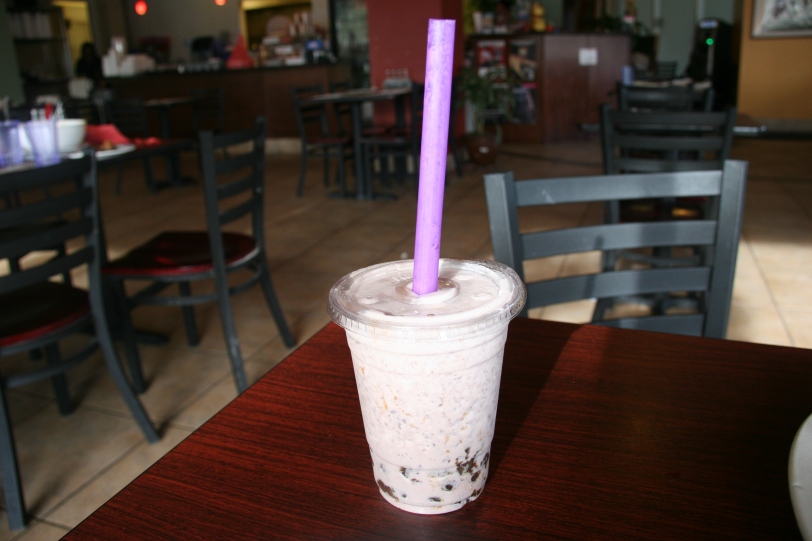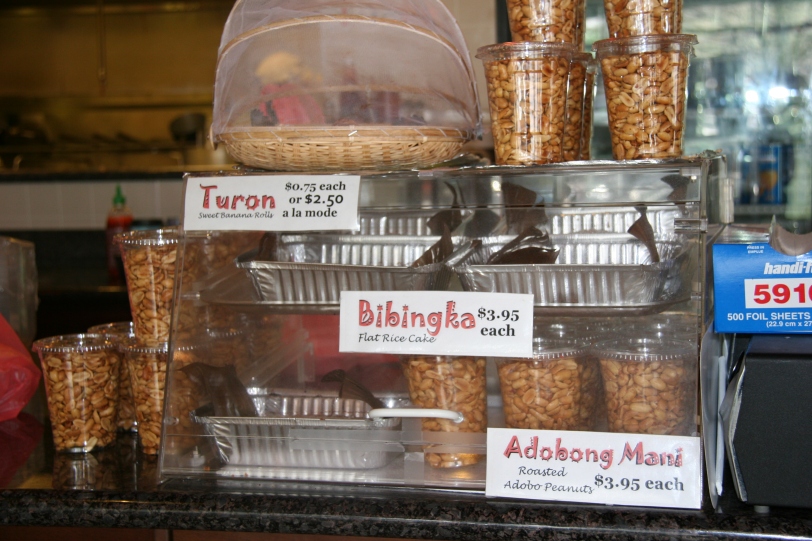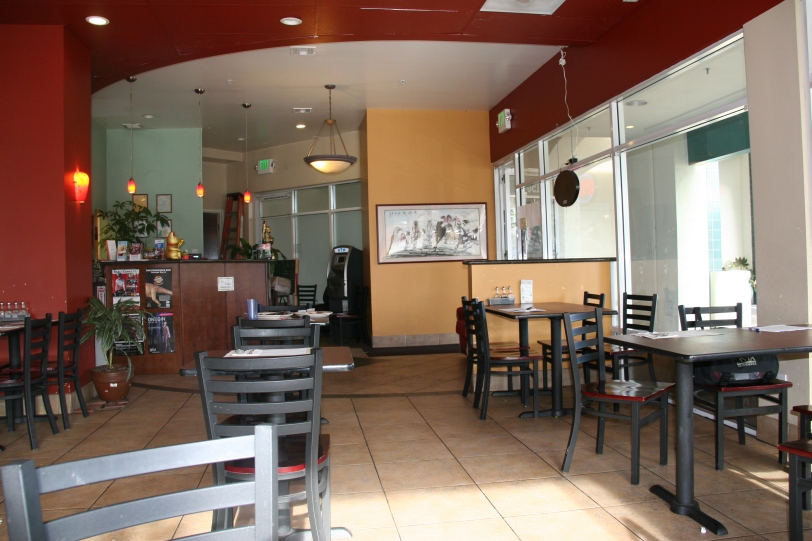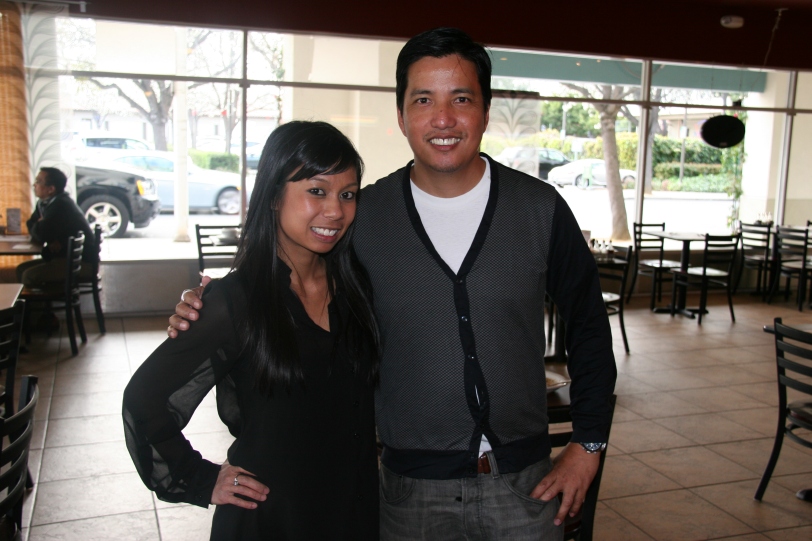Jesse takes some time to discuss the humor behind the name, why “scaredy-cats” order adobo and what it’s going to take to elevate Filipino food.
Toppings Tree is the closest Filipino restaurant to my house. A stone’s throw away from the prestigious Santa Clara University, it is a level playing ground for exploring Filipino food. For the younger generation, its dining room is spotless; its décor, trendy; its reviews on Yelp, plentiful. But for the older, characteristically proud Filipinos this setting is merely a façade for the traditional essences that wind delightfully through the dining room and bring favorable discourse all around.
Compiling a list of local Filipino restaurants, I was happy to visit Toppings Tree on the premise that it was a very current, relatable adversary for Filipino food. It’s respected and patronized ardently by the community and a positive departure from the Mom & Pop Filipino restaurants that may seem daunting to some.
A few days ago I had the pleasure of interviewing Jesse, the owner of Toppings Tree and he was generous enough to share his story with me. I hope you’ll enjoy it, along with the little unexpected pieces of history, wisdom and wit that emerged in our conversation.
Interview date: March 14th, 2013
K: How would you describe Filipino food?
J: It’s always been a mix. Because the Chinese and the Indians have been passing through the Philippines as a trading post. It was a trading post between the Chinese, the Indians and the Malays, that’s where they stop and trade their stuff. And then a lot of them just decided to stay. And that’s where the mixture of all of the flavors came about. And then of course we were colonized by Spain for 300 years so there’s a lot of influence in the cooking, and the food. Then the Americans colonized. But I don’t think that 3 years of occupation did much to the cooking.
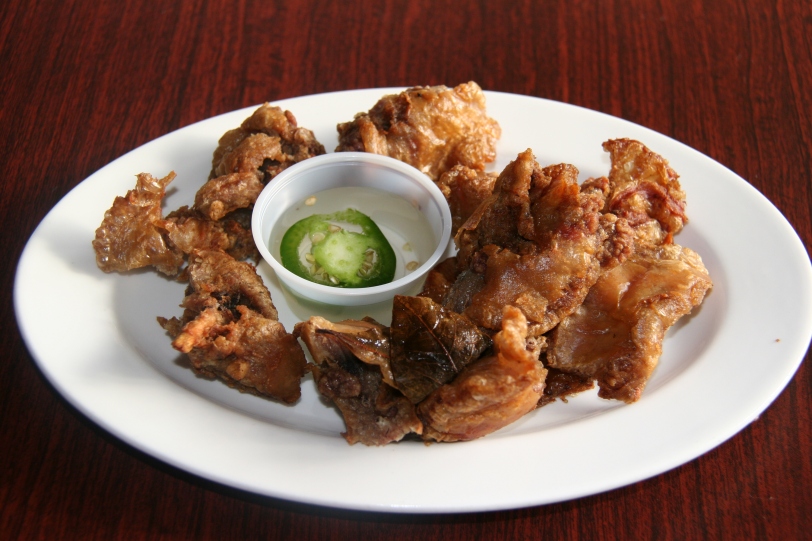
Topping’s Chicharon Bulaklak — deep fried pork ruffles served with vinegar and soy sauce. Addicting with a beer accompaniment.
K: Where do you think Filipino food is going, presently?
J: I love reading. Even when I was in grade school, I’m like a book junkie. And for the past 10 years, I guess, I’ve started reading for my own research about Filipino food in the states. Because the only thing you can find, especially in the bay area, used to be the carinderia, turo-turo. There was only 1 place you could get a freshly cooked meal: Barrio Fiesta. This was back in the 90s.
But now, there’s a lot more. And I think — this is just my personal opinion — I really think the added Filipino establishments in the past 5-10 years are because of the U.S. economy. A lot of people got laid off and the easiest thing that you can do is put up your business. For many, the first thing that comes to mind is a turo-turo (point-point) shop. I don’t know if you know this but in the bay area in the past 5-10 years a lot of places have started, that’s very exciting. That’s why I feel like I’m in the right place and the right time in the bay area because we have a Filipino base as well. We can experiment with different ways of presenting food. If you go fusion right away in a non-Filipino community it might be harder, because nobody might come and try your stuff out if they don’t know what Filipino food is.
K: Are you the original owner of Toppings Tree?
J: I’m the 3rd of a partnership. Toppings originated in the 90s in Daly City…and it’s still there. We’re called Toppings Tree because it’s the 3rd one in the series. We just changed the spelling. Toppings 2 is spelled “Toppings Too”. We’re the third one, so “tree” alludes to “three.”
K: Can you tell me a little bit about your personal background?
J: I was in Telecom. I was in product management and then I just, I was looking for something more than just regular office work. I got involved with Toppings Too because I knew the original owners there. I kind of liked it and when they decided to open this one up they offered it to me. I said yes. I needed a change, and here I am. I love it. I’ve been here since the very beginning, from planning, the architectural drawings and the construction.
K: Can you tell me a little bit about what the reaction was like when you first settled into the community?
J: Actually the good thing about us is that there were already two Toppings Tree. Because of the name, much of the local community here knew that it had to do with Filipino food. But for others, the name kind of sounds like a yogurt place. A lot of people didn’t even try us out at first because they were like, “Oh, it’s just a yogurt place.” Then people got curious and started coming by the door…when they didn’t try it I started talking to them; explained to them what Filipino food was, and one-by-one they started trying it out.
For many, Filipino food, is “greasy.”. The worst critics can be Filipinos who “wrap” Filipino food as greasy, not healthy. Those ideas came from Filipinos themselves. I think. That’s my personal opinion. We’re trying to get away from that. And maybe put a new spin on it so Filipino food will, someday, be just like a Chinese restaurant. I’m hoping that Filipino food will eventually be like one of people’s “to-go” places.
K: Can you describe a memorable experience where someone came in who never tried Filipino food before?
J: We have a lot of experiences like that, especially because we’re by the University. A lot of these kids, the new generation, they’re curious. They’re not afraid to try something new. They just come in, they read the description of the food and they’re like, what the heck – I’ll try it. What I always, always tell my servers to recommend to people when it’s their first time here is the tocino. I believe that tocino is very Filipino, but at the same time it’s not “scary” (as in not knowing what’s in there). It’s cured. Everyone is familiar with cured meat. Filipinos cure it differently though. Overall, I’d say it has a huge success rate. They come back for the tocino.
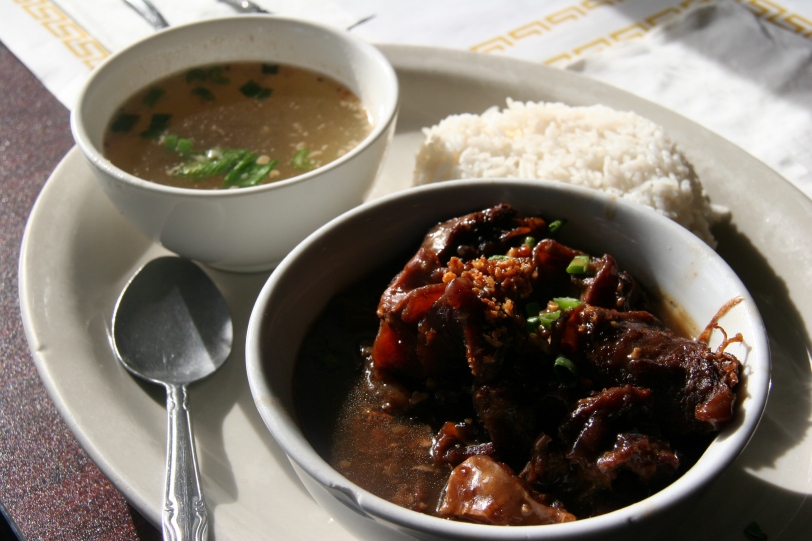
Beef Pares. Pare = “buddy” in Tagalog. One of the most famous and upcoming street foods in the Philippines. Juicy, tender beef served with a comforting (and balanced) chinese broth and rice.
K: Who makes up most of your customer base today?
J: It’s still mainly Filipinos. It’s [Santa Clara] a Catholic University. So we have Filipinos from the Philippines whose parents sent them here, to a Catholic University in the U.S. But our main base is Filipinos, whether they’re local or from the surrounding cities of Sunnyvale, San Jose or Milpitas. Slowly, I think we’re getting a lot of non-Filipinos – Chinese, Korean, Caucasians.
Working at a restaurant you get to basically, categorize our customers; like a “newbie”, or somebody who doesn’t want to try new things. Kind of like a scaredy-cat, you know. Scaredy-cats usually try adobo. And the adventurer, who would try something, the weirdest, they ask us for the weirdest food we have. Of course – it’s the dinuguan. Sometimes they’ll say, “is it really with B-L-O-O-D?” You know? They’ll actually spell it. (laughs) I’m like, yeah, it’s like any other part of the animal. You get to eat it when you cook it.
With the Crispy Pata, a lot of cultures use pork leg in their cooking. They use the upper part and discard the lower part. We Filipinos don’t want to put anything to waste so we cook the whole thing. That’s what Crispy Pata is. I see a lot of Vietnamese people like it. That surprised me. And with Filipinos they love it because it’s hard to make it as home as well. It’s a long process. You think it’s just fried pork but it’s a long process.
K: On your menu I noticed there were some Chinese food items. Was that deliberate, what was the intent behind that?
J: All of the Chinese dishes are very common in the Philippines as well. I know it’s Chinese, but it’s sort of like curry. Curry is an Asian thing. There’s a Filipino dish that consists of chicken curry. It became part of the food culture. This is kind of like the Chinese dishes that we have. For instance, the Chinese sausage with scrambled egg. The bihon, which is the pancit, has chinese toppings. We know that it’s Chinese but it’s been reinterpreted by us. There’s not distinctive line as to what is Filipino, what is Chinese, what is Indian, what is Malay, or what is Spanish. It’s just – it’s Filipino. We have some Spanish dishes as well, caldereta for example.
Today, if you go to the Philippines, it’s a different food landscape. There’s a lot of fusion, a lot of new dishes. I just came back from the Philippines a week ago and the food landscape has really changed. You think there are a lot of places to eat here? There are some new dishes I didn’t even recognize.
K: So when you came here after college, where did you get your Filipino food cravings?
J: I always cooked because my mom had a business and when I started grade school, my mom worked at a factory. It was right next to our house. I’d go there and she’d tell me what to cook, step-by-step. I’d go back, I’d put the pan, and then I’d go there, and say, “what do I do next?” and she’d say, “Oh put the oil.” And then I’d heat it up, and then I’d go back and say, “what do I do next?” That’s when I developed my cooking skills.
K: What are the most important flavors in Philippine cooking?
J: There is a lot of vinegar and soy sauce. That’s the first thing. And then, it’s a mixture – a little bit of Chinese, a little bit of Spanish, but it’s pure Filipino. It’s like, the mixture of all of these flavors and cooking techniques that became what is Filipino. Soy sauce, and garlic and vinegar – if you had these ingredients you could make all of Filipino foods.
Sometimes, when I first met people, they’ll ask me what kind of food we cook. I’ll immediately start with shanghai and chicken adobo, then put that aside. Most people are familiar with them, just because they’re in the bay area and there are a lot of Filipinos here. People when they order for someone who isn’t Filipino they order adobo, shanghai, and pancit. Just because that’s what they think they will like. I think for Filipino food to become a popular delicacy, we have to bring a new variety of Filipino food. Not just adobo, pancit and lumpia. Once I put that aside I start talking about the Spanish dishes and how we incorporate it into Filipino food. I tell them we have different sauces, cured meat and there’s a lot of Chinese influence too. And of course, we have dishes like sinigang, which is not Chinese or Spanish, but truly island food. That’s basically what island food is: the quint-essential Filipino food.
A lot of the traditional Filipino food can become elevated with better presentation. I think that the flavors should stay the same. I know in the past few years people have tinkered with the flavors and changing some of the ingredients. That’s good and all, but I think what’s going to make Filipino food more elevated is taking the original ingredients and just elevating the presentation. I think if we go into fusion and all that stuff, that’s not Filipino. Unfortunately, I think some of them got pressured into doing that because Filipino food is not popular. That was the hook to get other people interested in Filipino food…which was a good attempt.
But when you have “foodies” who want to get to know the culture of the food, you won’t be able to know the culture if you are cooking unnatural ingredients. Sometimes they do a goat adobo. I mean there’s goat there and all, but usually the flavor for adobo is not derived from goat. It may be Filipino food but the culture is not Filipino. It’s like, one great food with great flavor. Yeah that’s probably good. But if you want to know the culture, then that might not be the way.
K: Thank you. Lastly, what would be your strengths at Toppings Tree?
J: Our strengths are in the way we cook our food. We stick to those original ways we grew up with. As far as getting more people to eat Filipino food, I think that everybody – including other Filipino restaurants – shouldn’t see themselves as competitors, but more as advocates for Filipino food. A lot of customers come here and say, oh you have a new competitor, somebody has put up a new Filipino restaurant in Campbell. I said well you know that’s better; we’re all in the same boat – trying to get more people interested in Filipino food. And that’s how I view it. It’s not competition. I think the more Filipino restaurants the more for all restaurants, because there’s going to be more visibility. The general population won’t be as scared, so they’ll be more willing to try Filipino food and when they like particular dishes, they’ll go to all the restaurants and try it. Maybe there’s something they like better at other restaurants.
K: On that note, who’s cooking the food back there?
J: We have line cooks on a day-to-day basis. Our main cook goes between the 3 restaurants because all of the marinades, all of the ingredients are his. He goes from one place to the other and just comes here and does the marinades and checks with the line cooks to see how they’re doing, if they’re cooking everything right. But on a day-to-day basis our line cooks cook. He is here about 3-4 times a week.
K: Regarding the name: Toppings Tree. You were saying that “tree” was like “three”? Can you tell me a little more about that?
Yeah, it was the third one. Instead of putting number 3, we did a play of words so it won’t be so generic. Growing up in the Philippines, that kind of humor is very Filipino. So is misspelling a word. Because you know how Filipinos are, we put speaking English on a very high pedestal. So people who don’t speak English as well as other people, they make fun of them in a kind of joking manner. Filipinos love to joke. Toppings Two is spelled “Toppings Too” and Toppings Three is called “Toppings Tree”. That is Filipino humor. J
A huge amount of thanks goes to Jesse, the manager of Toppings Tree who entertained my questions and brought new dimension to our project. His viewpoints: thought provoking, true, and honest as they were, will be brought along as I continue this conversation. Trying the food was also extra-fulfilling after knowing the intent of the Toppings Tree and its proposed relationship with other Filipino food establishments. I am hoping that Toppings Tree remains a youthful adversary in Filipino food visibility for many years to come!
